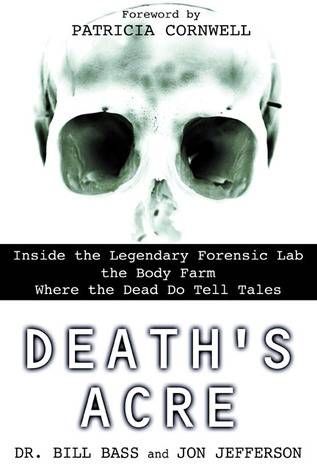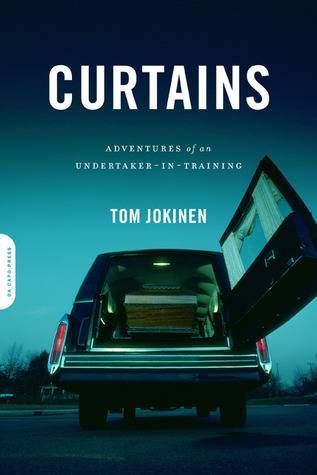
Bring Out Your Dead: 7 Nonfiction Books About the Science of Dead Bodies
This is a guest post from Darin Cook. Darin is a writer and avid reader of nearly all genres of nonfiction, with a healthy dose of fiction thrown in the mix on a regular basis. If reading food books and watching food shows without knowing how to cook very well were a clinical disease, he would be the poster child with no hope for recovery. Follow him on Twitter @darinBcook.
____________________
With Halloween approaching, people are talking about ghosts, skeletons, and zombies more than usual. The common link between these characters is their origin from dead bodies – a grisly way for a holiday to be portrayed, but something very familiar to the undertakers, coroners, embalmers, and forensic scientists who make a business out of death. These professionals (and the bodies they work with) are subjects in the following books about the science of corpses and the practical uses for dead bodies.
 The corpse itself is the main subject in Corpse: Nature, Forensics, and the Struggle to Pinpoint Time of Death by Jessica Snyder Sachs, but the people who investigate dead bodies become leading characters, making their mark in forensic science. This book describes scenes in which bodies are unexpectedly found in the woods, followed by experts determining the cause of death. It also outlines the contributions that classic murder cases (like Ted Bundy’s) made to forensics. It is fascinating from a scientific standpoint, but there isn’t anything whimsical about the dead bodies in Corpse.
The corpse itself is the main subject in Corpse: Nature, Forensics, and the Struggle to Pinpoint Time of Death by Jessica Snyder Sachs, but the people who investigate dead bodies become leading characters, making their mark in forensic science. This book describes scenes in which bodies are unexpectedly found in the woods, followed by experts determining the cause of death. It also outlines the contributions that classic murder cases (like Ted Bundy’s) made to forensics. It is fascinating from a scientific standpoint, but there isn’t anything whimsical about the dead bodies in Corpse.
 Mary Roach wrote Stiff: The Curious Lives of Human Cadavers in a more entertaining style, even though it may first appear to have taboo overtones. Roach’s book describes corpses that take on lives of their own by playing a role in experiments which help humankind, such as being used to practice plastic surgery, test safety features in vehicles as flesh and blood crash test dummies, design body armour, and ride the Space Shuttle in the name of rocket science research. Not all cadavers will lead the active post-mortem lives that Roach portrays, but she has a line in the book that is as marketable as a tagline for a tropical resort – “Death. It doesn’t have to be boring.”
Mary Roach wrote Stiff: The Curious Lives of Human Cadavers in a more entertaining style, even though it may first appear to have taboo overtones. Roach’s book describes corpses that take on lives of their own by playing a role in experiments which help humankind, such as being used to practice plastic surgery, test safety features in vehicles as flesh and blood crash test dummies, design body armour, and ride the Space Shuttle in the name of rocket science research. Not all cadavers will lead the active post-mortem lives that Roach portrays, but she has a line in the book that is as marketable as a tagline for a tropical resort – “Death. It doesn’t have to be boring.”
 One of the foremost experts in corpse research is Bill Bass, famous for creating the Body Farm in Tennessee as an outdoor laboratory for studying decomposition of dead bodies. He chronicled his long career in forensic anthropology in two books, Death’s Acre: Inside the Legendary Forensic Lab the Body Farm Where the Dead Do Tell Tales and Beyond the Body Farm: A Legendary Bone Detective Explores Murders, Mysteries, and The Revolution in Forensic Science. The knowledge he gleans from examining corpses has helped assess hundreds of criminal and medical cases, like the Charles Lindbergh murder trial and the injuries incurred by The Big Bopper in the 1959 plane crash. Fans of CSI will love the science that Bass brings to real homicide investigations in his books.
One of the foremost experts in corpse research is Bill Bass, famous for creating the Body Farm in Tennessee as an outdoor laboratory for studying decomposition of dead bodies. He chronicled his long career in forensic anthropology in two books, Death’s Acre: Inside the Legendary Forensic Lab the Body Farm Where the Dead Do Tell Tales and Beyond the Body Farm: A Legendary Bone Detective Explores Murders, Mysteries, and The Revolution in Forensic Science. The knowledge he gleans from examining corpses has helped assess hundreds of criminal and medical cases, like the Charles Lindbergh murder trial and the injuries incurred by The Big Bopper in the 1959 plane crash. Fans of CSI will love the science that Bass brings to real homicide investigations in his books.
 Cemetery Stories: Haunted Graveyards, Embalming Secrets, and the Life of a Corpse After Death by Katherine Ramsland gets into more anecdotes about the death care business and how funeral personnel act as a buffer between the corpse and the public to make a dead body appealing long enough for one final showing. It is the death care professionals Ramsland discusses most – undertakers, casket makers, cemetery caretakers, monument artists, hairstylists and cosmeticians. But there are also those she describes as being part of cemetery culture, such as necromancers and epitaph collectors.
Cemetery Stories: Haunted Graveyards, Embalming Secrets, and the Life of a Corpse After Death by Katherine Ramsland gets into more anecdotes about the death care business and how funeral personnel act as a buffer between the corpse and the public to make a dead body appealing long enough for one final showing. It is the death care professionals Ramsland discusses most – undertakers, casket makers, cemetery caretakers, monument artists, hairstylists and cosmeticians. But there are also those she describes as being part of cemetery culture, such as necromancers and epitaph collectors.
 For an in-depth look at the funeral business, Tom Jokinen writes about his foray as an apprentice at a Canadian funeral home in Curtains: Adventures of an Undertaker-in-Training that is witty and morbid all at the same time. The funeral industry is about respecting the dead, with unwritten rules to keep the industry’s reputation alive, such as never getting drive-thru food in a funeral vehicle that has a corpse in the back. On the frontlines, Jokinen is privy to all the rituals of funerals with its embalming fluids, caskets, headstones, hearses, and urns, but these are all simply convenient props for him to contemplate death.
For an in-depth look at the funeral business, Tom Jokinen writes about his foray as an apprentice at a Canadian funeral home in Curtains: Adventures of an Undertaker-in-Training that is witty and morbid all at the same time. The funeral industry is about respecting the dead, with unwritten rules to keep the industry’s reputation alive, such as never getting drive-thru food in a funeral vehicle that has a corpse in the back. On the frontlines, Jokinen is privy to all the rituals of funerals with its embalming fluids, caskets, headstones, hearses, and urns, but these are all simply convenient props for him to contemplate death.
 For a shocking read about humans close to death that did not make it to cadaver status, Jan Bondeson provides a look at premature burials in Buried Alive: The Terrifying History of our Most Primal Fear. It appears that hasty burials were a legitimate concern up to the nineteenth century. Bondeson provides numerous examples throughout history about how these deaths could have been misdiagnosed, all leading to an anti-premature-burial campaign in 1905 that reported nearly 200 cases of individuals dying in their coffins after being buried, and about the same number narrowly escaping the same horrifying doom.
For a shocking read about humans close to death that did not make it to cadaver status, Jan Bondeson provides a look at premature burials in Buried Alive: The Terrifying History of our Most Primal Fear. It appears that hasty burials were a legitimate concern up to the nineteenth century. Bondeson provides numerous examples throughout history about how these deaths could have been misdiagnosed, all leading to an anti-premature-burial campaign in 1905 that reported nearly 200 cases of individuals dying in their coffins after being buried, and about the same number narrowly escaping the same horrifying doom.
What are readers to take away from these books – curiosity or disgust that plastic surgery is practiced on decapitated heads? Readers who take the same stance as the authors may be shocked, but will not be offended. These books were written because authors are fascinated by the most unusual things the world has to offer. The shells of our bodies left behind after death just happen to be interesting subjects worthy of investigation.





